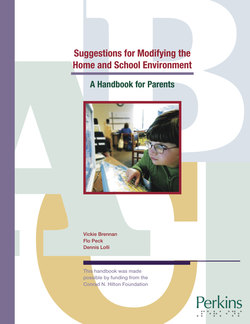Читать книгу Suggestions for Modifying the Home and School Environment: A Handbook for Parents - Dennis Lolli - Страница 3
ОглавлениеI. Introduction
This handbook has been designed for parents and teachers of children with dual sensory impairments and other physical limitations. It contains practical, affordable and easily implemented suggestions for enhancing a child's learning and mobility by making the environment more visible.
A child's environment—home, school program, and the community—plays an important role in how well the child is able to see and make use of his/her remaining vision. It is frequently assumed by parents, teachers and doctors that if a child does not benefit from glasses, optical devices or medical treatment nothing can be done to enhance a child's use of vision. The physical needs of the child with multiple impairments, as well as the needs of other children in the class, may overwhelm the parent or teacher preventing them from making simple modifications to the home or classroom. A child's use of functional vision can be greatly enhanced through observation of the child and experimentation with the environment, combined with knowledge of the visual disorder and how vision is affected.
No two children with visual impairments see the world the same way. There are many factors that influence how well a child sees in a particular situation and why one child sees better than another.
The most obvious factors concern the type of vision loss and how it affects visual acuity and fields, color reception, oculomotor and other visual functions. The child's cognitive ability, psychological makeup, level of motivation, social relationships and support system will also affect how the child approaches his or her visual impairment and the challenges it presents. Environmental factors are equally important in determining how well a child performs visually and these factors are often neglected or overlooked. Lighting, color and contrast, size and distance, and time are factors that can often be easily controlled with adaptations that require minimal effort and expense. The parent and teacher can create an environment or activity that provides the opportunity for the child to have successful visual experiences and encourages the use of their remaining vision.
Lighting
The quantity, type, direction, and position of illumination are critical to a child's visual performance. Some children are light-sensitive and may experience pain and discomfort from bright or direct light or glare. Other children need additional lighting to see optimally.
It is important to observe a child in a variety of lighting situations and to experiment with different light sources. Gooseneck lamps can be directed on the task and positioned to avoid glare. Desk lamps with rheostat controls can vary the amount of illumination. The distance between the light and the work surface will determine the amount of illumination. Many children with visual impairments prefer incandescent lighting or fluorescent lights without the blue spectrum. Work with the child to help him/her to position the lamp independently. Natural light should be used whenever possible. Facing into direct sources of light should avoided.
Color and Contrast
Another way to make it easier for a child to see is to increase the contrast between the object the child is working with and its background, and to reduce the number of items around the object. A child with low vision needs a more exaggerated difference between an object and its background for visibility. Black and white provide the greatest contrast, but other color combinations may be optimal, depending on the individual child. It is important to experiment with colors and sizes of objects, as well as types of lighting, when evaluating color contrast. Modifications can be made to a work surface, such as a table, desk, bureau, workbench, or counter top, by changing the color of the surface. This can be done easily and inexpensively through the use of contact paper, felt, construction paper, place mats and cafeteria trays. Also try changing the color of the objects placed on the surface; this will heighten contrast. Surfaces with confusing patterns should be avoided.
Size and Distance
When there is a loss of visual acuity, an object may be too small to be seen or to be seen well. Its image needs to be made larger for the child to see the object more clearly. This can be done in several ways. Moving closer to the object may make the object visible (i.e. the child moves closer to the chalkboard or television). Another option is to increase the size of the object or target (i.e. large print, enlarging materials). Optical devices such as reading glasses, closed circuit televisions, telescopes, and stand and hand-held magnifiers can all be used to magnify the image of an object. Each of these optical devices has its own limitations. A child should be evaluated for use of optical devices during the low vision evaluation with the eye doctor.
Time
The accuracy and speed of performing an activity decreases with the loss of vision. This aspect of visual functioning is often overlooked. Detecting, recognizing and then acting upon an object requires more time for a visually impaired child and can be especially difficult and time-consuming for a child with multiple impairments. In addition, the physical demands of using one's vision may cause eye fatigue and reduce the child's speed, accuracy, and attention. Objects and activities that are presented quickly or are in motion may be difficult to recognize. A visually impaired child may require more time to locate and discriminate an object. The length of time for visual activities should be increased gradually to avoid eye fatigue.
